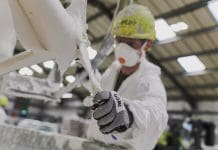Despite continuing to face challenges such as rising costs, skill shortages and supply chain issues, 2025 marks a pivotal year for construction to advance towards net zero goals, increase innovation and boost efficiency. But what strategies need to be prioritised to maintain momentum and take a step towards a more sustainable, efficient and resilient future?
With the fastest growth rate in two years, the construction industry can celebrate the success of 2024, with levels of work returning to some normality.
Part of this success is down to the increase in civil engineering projects, with an 18% rise in new projects, underpinned by large infrastructure investments across the UK.
Despite it being a long and winding rail project, HS2 is one notable project which has seen significant progress. Contractors ramped up tunnel boarding activities in London and the West Midlands, enabled through the launch of new machinery and used innovative engineering techniques, such as the UK’s first ever specialist cantilever process, to build several bridges and viaducts.
Ending the year with a new government in power has suggested some clarity on the expected growth of the industry for the year ahead.
With the government proposing to “invest, invest, invest”, sustainable building and tackling the housing crisis will be a key focus for the coming 12 months and we can expect the pace of activity for 2025 to ramp up.
Green construction in 2025
It’s clear that the future of construction is green and in 2025, reaching new limits will come down to keeping sustainable policies and practices at the forefront of the industry.
Recent research from NBS showed a marked improvement in both the number of projects with green objectives and the success rate in meeting these goals, compared with previous years.
Despite only one in five businesses currently measuring and reducing their carbon footprint, and one in four adjusting supply chains for sustainability, there is a significant opportunity for growth in this area next year.
However, to achieve significant progress, firms need to implement the core principles of the circular economy: reusing, recycling or repurposing materials and components.
A circular economy approach will minimise the need for new resources and reduce landfill waste, conserve resources and cut costs.
Innovative construction in 2025
Increased innovation is another must to allow the industry to continue to grow in 2025. According to recent research of over 1,000 technology decision-makers in construction, 87% of firms invest in new technologies to address their key business challenges, a number which is set to increase next year.
However, when it comes to understanding data, new technologies can be a concern for the industry, who have a variety of different systems and file formats working together to output information.
Since it’s becoming increasingly difficult to understand and absorb data in a way that is tangible, buildable and useful, a Common Data Environment (CDE) should be utilised as a
viable solution to improve productivity and profitability.
A CDE, which is a centralised system for managing all project documentation and data, makes it easier for all supply chain participants to access information, lowers the cost of storing and retrieving documents, and guarantees more accurate decision-making.
Upskilling the construction workforce
While firms can prioritise strategies to make progress in areas of sustainability and innovation next year, without an upskilled workforce, none of this will be possible.
According to Associated General Contractors (AGC), 85% of construction firms report they have open positions they are trying to fill. Among those firms, 88% are having trouble filling at least some of those positions.
In order to bridge the skills gap and guarantee the construction industry’s sustained prosperity, it is critical to promote construction careers to the younger generations and invest in training such as an increased number of apprenticeships, both on site and in office roles.
In a period of rapid change, including implementing new automated solutions, adjusting to new regulations, and developing green construction, firms need to take a more proactive approach to upskilling trades and attracting fresh talent in 2025.
The momentum from 2024, bolstered by infrastructure investments and government commitments, sets a promising foundation. To sustain it, construction firms must prioritise sustainability, adopt advanced technologies and circular economy practices and develop a skilled workforce. These efforts will ensure immediate goals are met while shaping a thriving industry beyond 2025.














